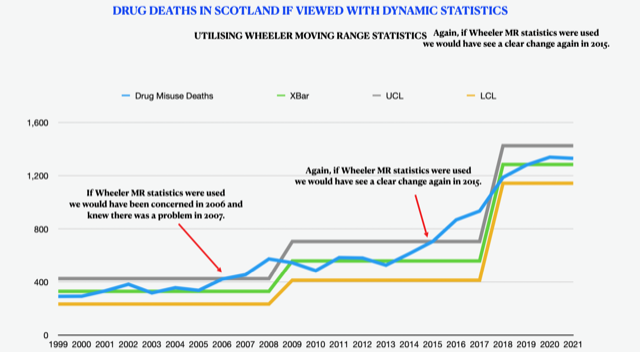In Scotland, the absence of a comprehensive system akin to the Coroners’ system in England and Wales raises questions about the accuracy of drug death statistics. In Scotland cause of death is investigated and assessed by the Crown Office and Procurator Service (COPFS). This process is run without any public scrutiny and with very limited family involvement. COPFS primary function is to assess for criminality and this may detract from any focus on causal factors outside of criminal behaviours. This is very unlike our southern counterparts, Scotland only public testing of sudden death relies on Fatal Accident Inquiries (FAI). This FAI review is primarily for death in institutions like prison, including drug overdoses and suicides in these environments. However, this approach hardly deals with the excessive number of drug related and suicidal deaths and is compounded by significant delays in reviews, often spanning years after the incidents. These delays not only hinder immediate learning and response but also cast doubt on the accuracy and completeness of drug death statistics.
The Consequences of Untested Investigations
The key change focuses on the fact that there is no evidence that the investigation (if there is one) is not timely, it is the review that is not.
The feedback from our group and current drug death families is that the scene was never protected and is symptomatic that a decision has been reached prior to any kind of investigation. As far as we can determine, only about a third of drug deaths are subject to Post Mortem and drug testing. As for FAI’s, there are only about 50/year and about 45 are for sudden death in Government institutions. The outcome that for almost all drug deaths the investigation or lack of is not open to any scrutiny whatsoever.
The current situation in Scotland regarding death rates presents a significant challenge, particularly due to the limitations in openly and thoroughly analysing the underlying causes and implications. This constraint hinders the ability of society to learn from and effectively address these issues. While the Police and Crown Office have commendably succeeded in reducing rates of homicide and serious crime, there remains a notable gap in the public review and understanding of incidents that are categorised as “non-crimes.” This gap underscores the need for more transparent and in-depth examination of all factors contributing to the nation’s health and safety.
When deaths are not promptly and thoroughly investigated, the true nature and scope of the issue remain obscured. It is impossible to determine how thorough investigations are when there is no public testing of this process. Anecdotal evidence is that on a number of occasions they are significantly below what would be expected. This lack of public testing investigation means that some drug-related deaths might be misclassified, underreported, or entirely overlooked. Consequently, the statistics that policymakers and health professionals depend on to combat the drug crisis could be misleading, painting an incomplete picture of the severity of the situation. The lack of public testing also prohibits family members of the deceased having the opportunity to ask important questions in an open environment.
Contrast with England
England’s use of a Coroners’ system for recording sudden deaths, including those due to drug overdoses, contrasts starkly with Scotland’s approach. In England, the Coroners’ system ensures that each sudden death is promptly and thoroughly investigated, leading to more accurate and immediate recording of drug-related fatalities. This deals not only with the cause of death but the circumstances of death, with an added requirement to ensure that any learnings that can be taken from the death are implemented where possible. This efficient process allows for real-time data collection, implementing immediate preventative actions and is crucial for understanding the true extent of the drug crisis and informing timely policy decisions.
In contrast, Scotland’s delayed and extremely low rate of Fatal Accident Inquiries greatly under-represents the actual drug death figures, impacting public health response and policy formulation. Unlike England, where a Coroners’ system provides a comprehensive and timely review of sudden deaths, Scotland employs Fatal Accident Inquiries (FAI). These inquiries often occur years after the incident, causing delays in data collection and potentially overlooking certain cases.
The Implications
This system’s inherent delay means that drug-related deaths may not be promptly identified or accurately classified. As a result, the official drug death statistics in Scotland may not reflect the actual situation, underreporting the true extent of the crisis. This discrepancy hinders effective policy-making and intervention strategies, as the data used to inform these decisions may not fully capture the scale of the drug problem or how the individuals came to die.
The Path Forward
To address this issue, adopting a more immediate and detailed review process, similar to the Coroners’ system in England, could improve the accuracy of drug death statistics, which in turn will improve learning from these tragic deaths in Scotland. Such a change is vital for a more effective response to the drug crisis, ensuring that policies and interventions are based on a true representation of the situation.
Scotland’s Need for Reform
It is clear that Scotland lacks a Coroners’ system like that in England and Wales, where over 30,000 sudden deaths are reviewed annually. In Scotland, the only method for examining these deaths is through the 50 or so Fatal Accident Inquiries (FAI), which often occur years after the death, leaving a significant gap in learning and understanding from these tragic incidents. This scarcity and delay in review means that critical opportunities for prevention and policy improvement are missed.
The need to discuss this matter with major political parties is crucial. It emphasises the need for a system that allows for timely and thorough investigation of sudden deaths, not only for legal and medical clarity but also to provide closure and understanding for grieving families. The current system’s limitations suggest a need for reform, especially considering the potential for learning and improving public health and safety measures from these investigations.
A Crucial Step for Scotland
Addressing this gap could lead to more effective strategies in addiction recovery and mental health support, areas that are evidently crucial in Scotland given the high rates of drug and suicide deaths. Implementing a more responsive and thorough review process for sudden deaths could be a significant step in understanding and mitigating these tragic occurrences.
The following slide by
presents an insightful analysis regarding the approach towards sudden deaths, particularly focusing on the context of drug-related fatalities. This analysis has been instrumental in informing politicians about the critical need for a more dynamic and real-time examination of data to detect early indicators of major issues.
The included chart utilises a Moving Range chart methodology to analyse drug deaths. This approach has revealed significant trends: a point of concern should have been identified as early as 2006, with clear evidence of an issue emerging in 2007.
The data also indicates a period of stabilisation until approximately 2014/15, followed by another concerning upward trend.
This methodology is particularly relevant in light of concerns about new more dangerous drugs appearing on the streets. Its application can bring a more incisive focus to ongoing debates. The effectiveness of this approach would be further enhanced by accessing data on a monthly or quarterly basis, allowing for more timely and responsive measures.
A critical challenge identified in this analysis is the lack of comprehensive accountability for sudden deaths in Scotland. Currently, any increase in such deaths is perceived more as a regrettable occurrence rather than a catalyst for accountability and action. Addressing this gap is essential for implementing effective strategies to mitigate these issues.
Annemarie Ward

